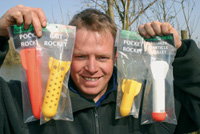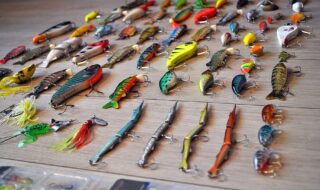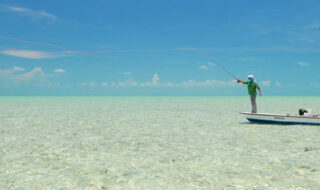By Chris Berry
Too many anglers are a bit trigger-happy when it comes to spodding and cannot wait to blast large amounts of bait out to the horizon. It is a fact that many anglers fall into the trap of automatically spodding on certain waters, the Linear Fisheries waters particularly spring to mind.
In the past, waters such as St John’s have responded well to spodding, but in recent years the carp have wised up to the tactic and it is less effective now.
There is also more to spodding than simply filling it with particles and firing it out – and what about all the different spods and their intended uses.
The Right Gear
Three items of tackle are musts for heavy-duty spodding, namely a strong rod, a big pit style reel and some sort of finger protection.
Large spods can, when full of bait, weigh as much as six ounces or more and so a strong rod is essential. Many companies make dedicated spod rods these days and a minimum test curve of around 4lb is required to cast big heavy spods.
The constant casting and retrieving of spods also requires a strong, large spooled reel in order to cope with the workload. As I prefer to use a braided main line, I also use a finger sleeve to stop the line cutting through my fingers.
Even with mono main lines, some form of protection is necessary. I know a lot of people use a golf glove on their right hand for spodding, but I prefer a dedicated neoprene finger protector made by a company in Wales for the sea fishing market.
If you do use a mono line, you will need to incorporate a strong leader of some description, but I would recommend a heavy breaking strain braid as it is durable and eliminates the need for leader knots.
Apart from these, you obviously need a selection of spods. There are plenty to choose from, but I prefer the spods from Gardner Tackle – they are strong, reliable and there is a spod in the range for all angling eventualities.
Horses For Courses
There are times when spodding is effective and definitely times when it is not recommended. A lot of the fishing that I do is on sparsely stocked waters for carp that have seen it all before. If I am fortunate to find fish I will not spod over the top of them, especially if they are
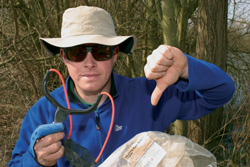 |
| Light, floating baits cannot always be catapulted far enough…so Chris spods using the Pocket Rocket to spod them out instead. |
feeding. I will, instead, find an alternative way of presenting a bait to them, such as a PVA bag or single hook bait.
There are times when spodding is the order of the day and, on waters that are very heavily stocked such as Drayton Reservoir, the carp will actually respond to the sound of a spod hitting the water, sounding the dinner bell.
If you are looking to deposit a large bed of bait then the spod is the best way of doing it. With the larger spods a few kilos of bait can be dropped onto a spot in next to no time and in this case, as well as when the spot you are feeding is at range, the spod will out-score the catapult.
Simple Spodding
The process is a simple one. Find the spot with a marker float and bring the float to the surface. Stand to one side of the marker rod and cast your rig to the float, ensuring that the marker will not pick up your line when you retrieve it. Then you can get on with spodding the bait at your marker float.
I would recommend that you have a cast or two to get your range and, once you have found it, place the line into the line clip on your reel. This ensures that the rest of your casts will fall in the right area. Be aware that, with the considerable weight of the spod, when the line hits the clip the spod can ping back slightly. For this reason, when the spod is about to reach the spot gently cushion the blow by nudging the rod forward slightly.
There are one or two other things to take into account. In windy conditions controlling the spod can be very difficult. A crosswind carries obvious hazards in keeping the spod on line. You will have to compensate for the wind by aiming slightly left or right, depending on the direction of the breeze.
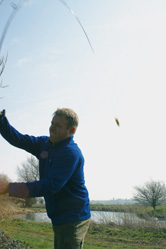 |
| A smooth cast is essential with heavy spods |
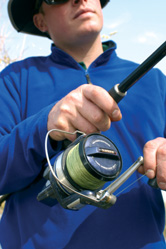 |
| A big reel and braided main line make spodding easy |
A headwind makes casting a spod hard work and a bit of a chore, whereas a helping wind is a rare joy for the spod user.
Each wind will also have an effect on the underwater conditions and tow, especially on shallower waters, will have to be compensated for when aiming the spod. It is very rare that bait being deposited from a spod will fall in a straight line to the bottom of the lake and so a little bit of thought should always be employed.
Finally, the cast made with a spod should be as smooth as possible – a fast and jerky cast will cause the contents to spill out and, in severe cases, can result in line breakages.
Top Tips
There are one or two tips that I would like to pass on to Total Carp readers about the use of spods. The first, and one of my favourites, is to plug the end of the spod with a couple of pieces of dissolving rig foam. The best way to do this is to stick three or four pieces together and use them to plug the spod. This ensures that you do not lose all the bait on the cast and is especially useful when spodding dry baits like boilies. The foam will dissolve in the water and allow the bait to fall out. Groundbait can also be used to create the same effect.
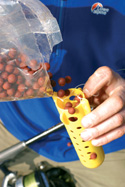 |
| Chris likes the Bait Rocket to feed boilies. He fills the spod threequarters full |
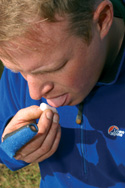 |
| Chris then licks and sticks together some rig foam |
 |
| Four pieces of foam are needed to plug the spod |
 |
| The foam is squeezed tightly inside the spod |
When using solid-sided spods with no holes, once I have put the bait into the spod I quickly dunk the spod in the water before casting out. This helps the bait to stick inside the spod and adds casting weight when using a small spod or one filled with light baits.
Here’s one that many anglers don’t even think about doing. When floater fishing, if the carp are out of catapult range – especially when it is windy – try using a small, light spod to cast a few mixers into the swim. As long as you don’t make too many casts you shouldn’t spook the carp, but you can get baits to them when that has been previously impossible.
I will even use my small spods at very short range on occasion. If I want to get a small amount of bait into a near margin but cannot reach over a tree to throw them in, and if the bait is too light to catapult in, I will drop a small spod full of bait to the spot quite easily.
If you fish waters with lots of bird life spods can be a godsend. On a lot of waters, birds will home-in on the sound of a catapult and they’ll know that this means somebody is putting food out. Seagulls on many lakes are even aware of what a throwing stick is. After allowing you to get away with throwing out a couple of baits, they will start diving. However, by using a spod you can eradicate this little problem.
Spodding Bags
I have been putting a bit of thought into my PVA bag fishing recently, particularly when casting bags over a baited area. We see anglers all the time spodding a bit of bait out and then casting a rig in a PVA bag over the top. What this creates is a scattering of bait around the swim, especially when the person spodding is not too accurate. Any carp that are mooching about in the area will find the small amount of bait around the lake bed and then all of a sudden come across a large pile of bait where the PVA bag has landed. Once a carp has been caught on this tactic a few times it might just start to wise up – particularly on some of the very pressured waters where the carp are not exactly lacking in the IQ stakes.
So. What I have decided on is to spod out tiny PVA bags of bait around a smallish area and then fish a similar sized bag over the top. This way, there is nothing that stands out and the pile of bait with the hook in it is the same as all the others around the swim.
 |
| Chris uses the Gardner Deluxe PVA stocking… |
 |
| …and uses a plastic tube to fill the PVA… |
 |
| …to make tiny bags of 10mm boilies… |
 |
| …which are dropped into the spod and cast out. |
Am I crediting the carp with too much intelligence or am I just trying to stay one step ahead of the carp and the anglers fishing for them? I like to think the latter, especially after seeing some of the carp behaviour on some of the hardest waters in the land. Today’s mug carp are tomorrow’s clever ones and the thought process of the angler needs to be up to scratch. Think about it.
Conclusion
There are definitely right and wrong times for spodding and all I would say to anglers is to use a bit of thought. Don’t fall into the trap of thinking that this water is a spodding venue and that water isn’t. Try it and find out for yourself, but be careful. No matter what the reputation and going method on a given water might be, there are no rules as far as the carp are concerned.
If you want to be good at spodding you will have to gain experience of doing it. Just like anything, practice makes perfect.
Chris’s Spod Guide
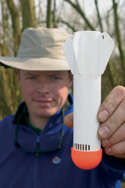 |
| Gardner Marker Particle Bullet |
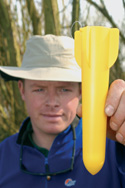 |
| Gardner Bait Rocket |
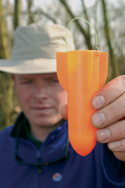 |
| Gardner Pocket Rocket |
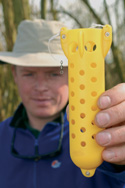 |
| Gardner Pocket Rocket XL |
Gardner Pocket Rocket
This miniature spod is ideal for casting out small amounts of bait accurately at short to medium range. The Pocket Rocket can actually be used with a standard carp rod of 2.75lb test curve or higher and so does not require a dedicated spod rod.
Using one of these for spodding large amounts of bait however, will take a very long time and I would recommend the use of a larger version in this case. The Pocket Rocket is also ideal for spodding mixers when floater fishing as the light design does not create too much disturbance when it hits the surface.
Gardner Pocket Rocket XL
This is the big brother of the Pocket Rocket and is basically just a bigger version. Because the Pocket Rocket is so aerodynamic and reliable, the larger version was introduced for spodding bigger amounts of bait.
The Pocket Rocket XL will require the use of a proper spod rod as the heavy spod, when full of bait, will break soft test curve rods. You will also need heavy-duty line and a decent sized reel for the larger Pocket Rocket.
Gardner Bait Rocket
This is the daddy of the Gardner spod family and is ideal for depositing large amounts of bait quickly. It has a very big capacity and so will require a strong spod rod and reel. When full, the Bait Rocket can weigh up to eight ounces and so a smooth accelerated cast is needed in order not to smash the rod or break the line.
The Bait Rocket features large holes along the length of the body, allowing quick release of particle baits and an easier retrieve as the water passes through it as you reel the spod back in.
Gardner Marker Particle Bullet
The marker Particle Bullet is another big spod with a large capacity for bait. This is especially good for depositing large amounts of small baits as the solid body prevents spillage in mid-flight. The white body with fluorescent orange head is ideal for long-distance spodding as they make the spod visible.
Just below the head of the Bullet are a series of slits in the body. These allow water to pass through and so reduce resistance on the retrieve. Again, a heavy-duty spod rod is required when using this spod, which can be very heavy when full of bait.


